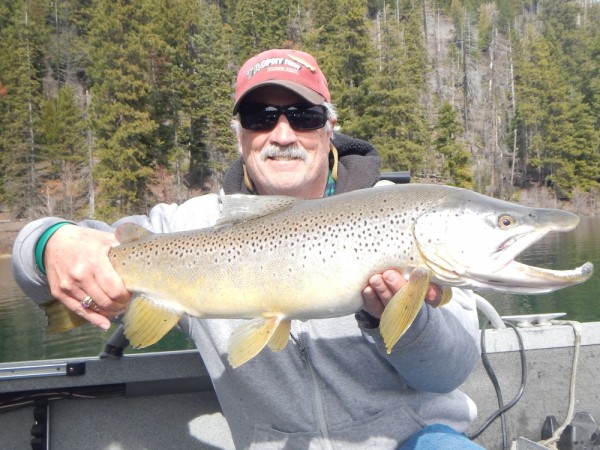
My 9th brown over 10 LBS. I'd rather be lucky than good!
Click to view image
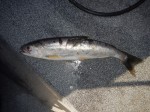
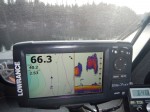
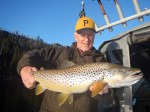
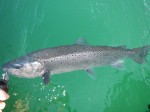
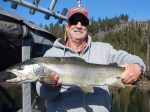
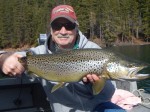
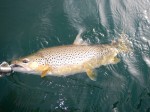
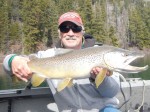
When Allan Cole started the Brownbaggers back in the early 70’s, he set the bar at 10 LBS. for the minimum size with (2) required for entry. I doubt he knew at the time, but his “line of demarcation” was spot on. Let me give you some of my own personal records to make the point. Though I don’t know the exact number of 9 LB.+ browns I have caught, I think I would be in the ballpark at north of 80. I have lived up here in Central Oregon for over 20 years now and average about 3-5 a year.....you can do the math. Out of those 80, only 9 have been over 10 LBS. I can’t say for sure how many I might have lost but I have seen (2) of them that were easily over the mark. The point I am trying to make is that the percentage of browns caught over 10 LBS. drops considerably!!
In Bernie Taylors book, “Big Trout, How and Where to Target Trophies”, he shows a graph on page 28 that was formulated by a fishery biologist named Vidergar that illustrates the percentage of the total population based on age and size. It specifically covers the gerrard rainbow (largest native rainbows in the world) population in Lake Pend Oreille. I don’t know if you could apply it to brown trout but if so, only 16% of the total estimated population were bigger than 29 inches and 15 LBS.. If that is a good general view, you would have to wade through lots of smaller trout to get a specimen that big, unless your real lucky! You can get more info on Bernie’s book on my Product Review page....it is one of my favorite books on trophy trout and well worth the investment
The younger crowd calls them “double digits” but us old geezers still refer to them as 10 LB.+ browns. Whatever you choose to call them, they attract a small but dedicated group of hardcore anglers who value them dearly and with good reason.....they are hard to come by!! I would liken the pursuit of them to putting a giant puzzle together. As you get some pieces to fit, you get a little bit of the picture. The more pieces you get....a little more is revealed. You will never get all the pieces but you can continue to expand the puzzle and understand and learn more. Actually, I think this would be true of any endeavor if you think about it.
When I was doing trophy trout fishing seminars on the outdoor show circuit over the last 20 years, I would always start with location. You want to identify the lakes in your region that hold big browns or whatever species you are after for that matter. Your research should take into account plantings, lake records, and a history of big browns caught, just to name a few. Up here in Oregon, Wickiup, East, Paulina and Crescent Lakes have all produced browns in excess of 20 LBS. In California, Lower and Upper Twins have produced the last (3) State records and Stampede was a brown trout factory for many years before this last devastating drought! The White River in Arkansas is another hot spot and previously produced a World Record brown back in the early 90’s. Most of the savvy big brown anglers know the history of Flaming Gorge and the huge browns it produced including the World Record back in 1977. The Great Lakes seem to produce the biggest and most numbers of big browns these days with (2) of the last (3) World Record browns coming from Lake Michigan.
When Mark Knoch and I were back in Milwaukee Harbor filming our Monster Trout 4 DVD several years ago, the fishing was pretty crazy the first morning we got out with Jason Woda of Reelsensations Guide Service. In a matter of a few hours, Mark caught a 12 LB. Seforellen Brown and then an 11 LB. domestic brown. If I wouldn’t have knocked off another 10 LB.+ brown he had on, Mark would have caught (3) over 10 LBS. in a little less than four hours!! You can check it out for yourself by renting the digital download in the TTG Store of this website if you like. That is why Allan requires browns from the Great Lakes to be over 15 LB. for submission to the Brownbagger list. From Terra Del Fuego to New Zealand, I could go on and on about where to go.....deep pockets would help on these last two though!
I’m not going to give you all the pieces in my puzzle (you probably already knew that) but here are a few on equipment and technique. To start with and most of you know this but for those who don’t, you can pull a minnow type plug around early and late in the day working water of 10-20 feet and you will hook some browns. If you are working the lure by sweeping (rippin’) your rod back and forth erratically, you will catch even more browns. The same applies to using leadcore and working out in deeper water and employing the same technique.....there is a bit of a learning curve on rods, reels, knots, and leaders, but it is well worth the effort to learn.
Downriggers are another tool that can improve your chances. I still like Scotty's the best but have been running Walkers for the last 10-12 years and really like the auto weight retrieval system that brings your ball right to you! When lakes stratify in the late Spring or early summer, depending on the locations and elevations, the riggers and leadcore are both deadly to reach the thermocline where the bait and trout will be hanging out. They will usually be there clear up until sometime in the Fall when water temps drop and even out more from top to bottom. Another related tool is the Downjigger, a device that works with your downrigger and imparts action to your lure while on the rigger. For more information on it, check out my Product Review page for contact info and performance stats. I have caught many nice browns on them.
Another approach is jigging for browns. I have a few good friends that have become very proficient at it and have caught browns over 10 LB. working jigs on them. I was slow to embrace this technique but have caught some browns while working jigs but honestly, I am not that good at it....I’m probably too impatient and it takes some skill to stay over them.
The area of lures is probably the most controversial of all. To start with, I will say that I think it is pretty much over rated. I can tell you for a fact that many big browns have been caught on lots of lures including Rapala’s, Rebels, A/C plugs, Yozuri’s, Lucky Craft, Megabass, Storm, Lyman’s, Excalibur’s and many, many more. My personal preference of size is the 4.5-5.5 inch range baits but I have caught some big browns on lures as big as 7-8 inch models. The basic standard patterns for here on the West Coast would be kokanee, rainbow and chub because they are the prevalent forage in most of our lakes that hold browns. I have seen many kokanee and chubs spit up right at the boat and the sizes correlate with my bait sizes mentioned previously. You will need to investigate the lakes you are targeting to determine just what the forage base looks like. Many hold various minnows, pond smelt, pogies, shad, shiners and too many more to list. Some other colors like chartreuse and white also seem to bang some big fish even though they don’t really represent any forage I can think of except an Albino in the case of white.
Last but not least, I think that maybe the best thing you can do is study and learn everything you can about browns. They are without a doubt one of the toughest of all trout species to catch consistently until you learn some of the patterns of their behavior. I think that presentation is probably the most important thing to learn.....much more than the lures. Putting a lure right in front of a feeding trout is your best shot and that has both some luck and skill involved. Some of the other things to consider are weather, barometer, light conditions and another useful tool....the Solunar Tables. My use of them this last year has been better than previous years and I am not sure why.
I will close by saying I would like to encourage the younger anglers to consider this endeavor......the rewards can be great! It seems that fishing overall is declining in our country and in many states, the license sales have declined dramatically. I hope you will teach your children how to fish and enjoy this great sport and pass on this part of our American heritage.
Tight Lines,
Rick